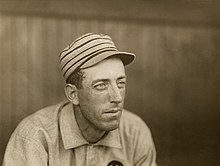Eddie Plank
Edward Stewart Plank (August 31, 1875 – February 24, 1926), nicknamed "Gettysburg Eddie", was an American professional baseball player.
Plank had only a 1.32 earned run average (ERA) in his World Series career, but he was unlucky, with a 2-5 win–loss record in those games.
He practiced pitching by throwing a baseball against his barn door, drawing lectures from his father for all the dents he left.
[3] When Plank was about 22, Frank Foreman, the pitching coach at Gettysburg College, asked him to try out for the school's baseball team.
[17] His quiet personality led to him getting overshadowed in media coverage by other Athletics pitchers such as Hall of Famers Waddell and Chief Bender, but Plank would win more games than either of these.
"[20] He played for the outlaw league's St. Louis Terriers and won 21 games, the eighth and final time he reached the 20-win plateau.
When the Federal League folded, Plank applied for free agency but was declared to belong to the St. Louis Browns for 1916.
"[21] However, by June 1917 newspapers reported that Plank's career was nearly over; he had struggled with arm problems and had left the team at one point due to a nervous breakdown.
Despite his announcement, the New York Yankees traded pitchers Urban Shocker and Nick Cullop, infielders Fritz Maisel and Joe Gedeon, catcher Les Nunamaker, and cash to the Browns for Plank and Del Pratt.
Thrown across his body, it reached home plate at an angle, making it difficult for hitters to track, especially if they were left-handed.
[16] His consistent performance and strong work ethic led Mack to use him frequently, part of the reason Plank at times developed sore arms during his career.
[16] Plank was also known for his long pauses on the mound, which some claimed lengthened the duration of the games in which he pitched.
They had a son, named Edward Stewart Plank Jr.[1] According to baseball historian Frank Russo, he was "as solid a family man as you could ever find.
[25] Friendly by nature, Plank did the unusual by taking time to mentor the rookie pitchers on the Athletics' staff, and he befriended Louis Van Zelst, a hunchback who served as the team's mascot.
Steelton was only 40 miles (64 km) from his home and the arrangement allowed him to manage his business during the week.
[26] Plank did not seem to be in ill health after his career, but on February 22, 1926, his wife awoke to discover her husband paralyzed on the left side due to a stroke and suffering garbled speech.
The pitcher showed signs of recovery briefly, then started having bouts of lost consciousness.
[27] Upon hearing of Plank's death, Connie Mack said that he felt like a father who had just lost a son.
He was short and light, as pitchers go, but he made up for the physical defects, if such they were, by his study of the game and his smartness when he was on the pitching peak", he said.
[29] Former teammate Jack Coombs said, "I have always been thankful that I was thrown into such intimate contact with so inspiring a man in the days when the majority of ballplayers were of a much lower type than at the present time.
[4] Babe Ruth thought he was the hardest pitcher to hit, and Ty Cobb selected him to his all-time team.
